Strategic Vertiport Placement for Airport Access: Utilizing Urban Air Mobility for Accelerated and Reliable Transportation
Abstract
1. Introduction
- How can infrastructure placement be guided efficiently through spatial considerations of the demand it is destined to serve?
- Are there solution methods that are able to retain an accessible service under conflicting objectives of minimizing infrastructure costs and maximizing demand coverage?
- What are the trade-offs between accessibility and demand coverage, versus operational costs?
- Introducing a strategic facility placement framework for UAM infrastructure, based on the adapted formulations of existing Facility Location Problems (the Capacitated Facility Location Problem and the Maximal Covering Location Problem).
- Developing and evaluating different solution methods that can be used on FLPs, based on existing formulations (k-means clustering, heuristics, and MILP).
- Providing insights into the spatial distribution of a potential airport-bound UAM demand and the role of infrastructure constraints in balancing service efficiency with facility investment.
2. Background Review
2.1. Previous Work on the Vertiport Location Identification Problem
2.2. Facility Location Problem
2.3. Capacitated Facility Location Problem
2.4. k-Means Algorithm with Capacity Constraints
2.5. Greedy Heuristics for the Solution of FLPs
2.6. Maximal Coverage Location Problem
3. Methodology
3.1. Capacitated Facility Location Problem Formulation
3.2. Solution Methods
3.2.1. Capacitated k-Means
3.2.2. Greedy Heuristic Algorithm
| Algorithm 1: Greedy heuristic |
| 1 Run k – means (initialization) |
| 2 Set , , |
| 3 If |
| 4 while |
| 5 Set |
| 6 Set , and solve the CFLP |
| 7 Let |
| 8 while is |
| 9 Set , and solve the CFLP |
| 10 If |
| 11 Set |
| 12 Set |
| 13 Else |
| 14 If |
| 15 Let |
| 16 Else |
| 17 If |
| 18 Set , and solve the CFLP |
| 19 If |
| 20 Set |
| 21 Set |
| 22 Else |
| 23 Set |
| 24 Set |
| 25 Else |
| 26 Set |
| 27 Set |
| 28 Terminate |
3.2.3. Adapted Maximal Covering Location Problem Formulation
4. Applications and Results
4.1. Cost Function Framework for UAM Airport Access Trips
4.2. Data
4.3. Numerical Analysis
4.3.1. Capacitated k-Means Results
4.3.2. Greedy Heuristic Algorithm
4.3.3. Adapted MCLP
5. Conclusions
5.1. Discussion
5.2. Limitations
5.3. Future Steps
- Incorporating heterogeneous vertiport types and infrastructure profiles, allowing site-specific customization.
- Embedding regulatory and spatial constraints into the optimization model, using GIS-based exclusion zones and legal data layers.
- Modeling time-dependent demand and vehicle availability, possibly using agent-based or discrete-event simulation.
- Developing full-cost models to analyze trade-offs between infrastructure investment, operational performance, and user pricing.
- Expanding the demand base and behavioral modeling to include private vehicle users, new market segments, and uncertainty in adoption.
- Integrating environmental and equity metrics, including noise impact zones, environmental justice indicators, and the spatial distribution of benefits.
Author Contributions
Funding
Data Availability Statement
Acknowledgments
Conflicts of Interest
References
- Reiche, C.; Goyal, R.; Cohen, A.; Serrao, J.; Kimmel, S.; Fernando, C.; Shaheen, S. Urban Air Mobility Market Study; NASA: Washington, DC, USA, 2018. [Google Scholar] [CrossRef]
- Coogan, M.A. Ground Access to Major Airports by Public Transportation; Transportation Research Board: Washington, DC, USA, 2008. [Google Scholar]
- Mohammed, A.; Roisman, R. Washington-Baltimore Regional Air Passenger Survey; Metropolitan Washington Council of Governments: Washington, DC, USA, 2013. [Google Scholar]
- Harvey, G. Study of Airport Access Mode Choice. J. Transp. Eng. 1986, 112, 525–545. [Google Scholar] [CrossRef]
- Gokasar, I.; Gunay, G. Modeling and Implications of Airport Ground Egress Mode Choice. KSCE J. Civ. Eng. 2021, 25, 669–679. [Google Scholar] [CrossRef]
- FAA. Air Traffic by the Numbers; Federal Aviation Agency: Washington, DC, USA, 2024. [Google Scholar]
- Wu, Z.; Zhang, Y. Integrated Network Design and Demand Forecast for On-Demand Urban Air Mobility. Engineering 2021, 7, 473–487. [Google Scholar] [CrossRef]
- Rimjha, M.; Trani, A. Urban Air Mobility: Factors Affecting Vertiport Capacity. In Proceedings of the 2021 Integrated Communications Navigation and Surveillance Conference (ICNS), Dulles, VA, USA, 19–23 April 2021. [Google Scholar]
- MacQueen, J. Some Methods for Classification and Analysis of Multivariate Observations. In Proceedings of the Fifth Berkeley Symposium on Mathematical Statistics and Probability; The Regents of the University of California: Oakland, CA, USA, 1967. [Google Scholar]
- Anderberg, M.R. Cluster Analysis for Applications: Probability and Mathematical Statistics: A Series of Monographs and Textbooks; Academic Press: Cambridge, MA, USA, 2014. [Google Scholar]
- Sinha, A.A.; Rajendran, S. A Novel Two-Phase Location Analytics Model for Determining Operating Station Locations of Emerging Air Taxi Services. Decis. Anal. J. 2022, 2, 100013. [Google Scholar] [CrossRef]
- Brühl, R.; Lindner, M.; Fricke, H. Locating Air Taxi Infrastructure in Regional Areas—The Saxony Use Case; Technische Universität Dresden: Dresden, Germany, 2022. [Google Scholar]
- Arellano, S. A Data-and Demand-Based Approach at Identifying; Department of Civil, Geo, and Environmental Engineering, Technical University of Munich: Munich, Germany, 2020. [Google Scholar]
- Holden Jeff Goel, N. Fast-Forwarding to a Future of On-Demand Urban Air Transportation; Uber Elevate: Los Angeles, CA, USA, 2016. [Google Scholar]
- Lim, E.; Hwang, H. The Selection of Vertiport Location for On-Demand Mobility and Its Application to Seoul Metro Area. Int. J. Aeronaut. Space Sci. 2019, 20, 260–272. [Google Scholar] [CrossRef]
- Rajendran, S.; Zack, J. Insights on Strategic Air Taxi Network Infrastructure Locations Using an Iterative Constrained Clustering Approach. Transp. Res. Part E Logist. Transp. Rev. 2019, 128, 470–505. [Google Scholar] [CrossRef]
- Jeong, J.; So, M.; Hwang, H.-Y. Selection of Vertiports Using K-Means Algorithm and Noise Analyses for Urban Air Mobility (UAM) in the Seoul Metropolitan Area. Appl. Sci. 2021, 11, 5729. [Google Scholar] [CrossRef]
- Peng, X.; Bulusu, V.; Sengupta, R. Hierarchical Vertiport Network Design for On-Demand Multi-Modal Urban Air Mobility. In Proceedings of the 2022 IEEE/AIAA 41st Digital Avionics Systems Conference (DASC), Portsmouth, VA, USA, 18–22 September 2022. [Google Scholar]
- Rajendran, S. Study on Facility Location of Air Taxi Skyports Using a Prescriptive Analytics Approach. SSRN Electron. J. 2021, 18, 100761. [Google Scholar] [CrossRef]
- Kai, W.; Jacquillat, A.; Vaze, V. Vertiport Planning for Urban Aerial Mobility: An Adaptive Discretization Approach. Manuf. Serv. Oper. Manag. 2022, 24, 3215–3235. [Google Scholar] [CrossRef]
- Rath, S.; Chow, J.Y.J. Air Taxi Skyport Location Problem with Single-Allocation Choice-Constrained Elastic Demand for Airport Access. J. Air Transp. Manag. 2022, 105, 102294. [Google Scholar] [CrossRef]
- Fadhil, D.N. A GIS-Based Analysis for Selecting Ground Infrastructure Locations for Urban Air Mobility; Technical University of Munich: Munich, Germany, 2018. [Google Scholar]
- Boutilier, J.J.; Chan, T.C.Y. Drone Network Design for Cardiac Arrest Response. Manuf. Serv. Oper. Manag. 2022, 24, 2407–2424. [Google Scholar] [CrossRef]
- Willey, L.C.; Salmon, J.L. A Method for Urban Air Mobility Network Design Using Hub Location and Subgraph Isomorphism. Transp. Res. Part C Emerg. Technol. 2021, 125, 102997. [Google Scholar] [CrossRef]
- Karatas, M.; Yakıcı, E. An Iterative Solution Approach to a Multi-Objective Facility Location Problem. Appl. Soft Comput. 2018, 62, 272–287. [Google Scholar] [CrossRef]
- Volakakis, V.; Mahmassani, H.S. Vertiport infrastructure location optimization for equitable access to urban air mobility. Infrastructures 2024, 9, 239. [Google Scholar] [CrossRef]
- Yu, Y.; Wang, M.; Mesbahi, M.; Topcu, U. Vertiport Selection in Hybrid Air-Ground Transportation Networks via Mathematical Programs with Equilibrium Constraints. IEEE Trans. Control. Netw. Syst. 2023, 10, 21082119. [Google Scholar] [CrossRef]
- Ribeiro, J.K.; Borille, G.M.R.; Caetano, M.; da Silva, E.J. Repurposing Urban Air Mobility Infrastructure for Sustainable Transportation in Metropolitan Cities: A Case Study of Vertiports in São Paulo, Brazil. Sustain. Cities Soc. 2023, 98, 104797. [Google Scholar] [CrossRef]
- Mavraj, G.; Eltgen, J.; Fraske, T.; Swaid, M.; Berling, J.; Röntgen, O.; Fu, Y.; Schulz, D. A Systematic Review of Ground-Based Infrastructure for the Innovative Urban Air Mobility. Trans. AerosRes. 2022, 2022, 1–17. [Google Scholar] [CrossRef]
- Rahman, B.; Bridgelall, R.; Habib, M.F.; Motuba, D. Integrating Urban Air Mobility into a Public Transit System: A GIS-Based Approach to Identify Candidate Locations for Vertiports. Vehicles 2023, 1803, 5–1817. [Google Scholar] [CrossRef]
- Rothfeld, R.; Fu, M.; Balać, M.; Antoniou, C. Potential Urban Air Mobility Travel Time Savings: An Exploratory Analysis of Munich, Paris, and San Francisco. Sustainability 2021, 2217, 13. [Google Scholar] [CrossRef]
- Li, X. Repurposing Existing Infrastructure for Urban Air Mobility: A Scenario Analysis in Southern California. Drones 2023, 7, 37. [Google Scholar] [CrossRef]
- Rajendran, S.; Srinivas, S. Air taxi service for urban mobility: A critical review of recent developments, future challenges, and opportunities. TransRes. Part E Logist. TransRev. 2020, 1020, 14390. [Google Scholar] [CrossRef]
- Patel, S.R. Urban Air Mobility Network Asset Acquisition Optimization. Ph.D. Thesis, Purdue University Graduate School, West Lafayette, IN, USA, 2023. [Google Scholar]
- Maheshwari, A.; Mudumba, S.; Sells, B.E.; DeLaurentis, D.A.; Crossley, W.A. Identifying and analyzing operations limits for passenger-carrying urban air mobility missions. In Proceeding of the 2020 AIAA Aviation and Aeronautics Forum and Expo-sition, Virtual, 15–19 June 2020; p. 2913. [Google Scholar]
- Li, S.; Lee, S. Prediction of Urban Air Mobility Multirotor VTOL Broadband Noise Using UCD-QuietFly. J. Am. Helicopter Soc. 2021, 66, 1–13. [Google Scholar] [CrossRef]
- Glaab, P.; Wieland, F.; Santos, M.; Sharma, R.; Tamburro, R.; Lee, P.U. Simulating fleet noise for notional uam vehicles and operations in New York. In Proceedings of the 2019 IEEE/AIAA 38th Digital Avionics Systems Conference (DASC), San Diego, CA, USA, 8–12 September 2019; pp. 1–10. [Google Scholar] [CrossRef]
- Clarke, M.A. Towards a Regional and Urban Air Mobility Future: The Development of Computational Approaches for Quantifying Trade-offs in Electric Aircraft Design; Stanford University: Stanford, CA, USA, 2022. [Google Scholar]
- Venkatesh, N.; Payan, A.P.; Justin, C.Y.; Kee, E.; Mavris, D. Optimal Siting of Sub-Urban Air Mobility (sUAM) Ground Archi-tectures Using Network Flow Formulation. In Proceedings of the AIAA AVIATION 2020 FORUM, Reno, NV, USA, 15–19 June 2020; p. 2921. [Google Scholar]
- Kotwicz Herniczek, M.T.; German, B.J. Impact of airspace restrictions on urban air mobility airport shuttle service route feasibility. Transp. Res. Rec. 2022, 2676, 689–706. [Google Scholar] [CrossRef]
- Sells, B.E.; Maheshwari, A.; Chao, H.; Wright, E.; Crossley, W.; Sun, D. Evaluating the impact of urban air mobility aerodrome siting on mode choice. In AIAA AVIATION 2021 FORUM; Aerospace Research Center: Columbus, OH, USA, 2021; p. 2371. [Google Scholar]
- Rimjha, M.; Hotle, S.; Trani, A.; Hinze, N.; Smith, J.; Dollyhigh, S. Urban air mobility: Airport ground access demand estimation. In AIAA Aviation 2021 Forum; Aerospace Research Center: Columbus, OH, USA, 2021; p. 3209. [Google Scholar]
- Larson, R.C.; Odoni, A.R. Urban Operations Research; Prentice-Hall: Upper Saddle River, NJ, USA, 1981. [Google Scholar]
- Daskin, M.S. Network and Discrete Location: Models, Algorithms, and Applications, 2nd ed.; John Wiley & Sons: Hoboken, NJ, USA, 2013. [Google Scholar] [CrossRef]
- Balinski, M.L. Integer Programming: Methods, Uses, Computations. Manag. Sci. 1965, 12, 253–313. [Google Scholar] [CrossRef]
- Larson, R.C. A hypercube queuing model for facility location and redistricting in urban emergency services. Comput. Oper. Res. 1974, 1, 67–95. [Google Scholar] [CrossRef]
- Kuehn, A.A.; Hamburger, M.J. A Heuristic Program for Locating Warehouses. Manag. Sci. 1963, 9, 643–666. [Google Scholar] [CrossRef]
- Zanjirani Farahani, R.; Hekmatfar, M. (Eds.) Facility Location: Concepts, Models, Algorithms and Case Studies; Physica-Verlag HD: Heidelberg, Germany, 2009. [Google Scholar]
- Cornuéjols, G.; Wolsey, L. The Uncapicitated Facility Location Problem; Cornell University Operations Research and Industrial Engineering: Ithaca, NY, USA, 1983. [Google Scholar]
- Sridharan, R. The capacitated plant location problem. Eur. J. Oper. Res. 1995, 87, 203–213. [Google Scholar] [CrossRef]
- Raghavan, S.; Sahin, M.; Salman, F.S. The Capacitated Mobile Facility Location Problem. Eur. J. Oper. Res. 2019, 277, 507–520. [Google Scholar] [CrossRef]
- Melkote, S.; Daskin, M.S. Capacitated Facility Location/Network Design Problems. Eur. J. Oper. Res. 2001, 129, 481–495. [Google Scholar] [CrossRef]
- Wu, L.-Y.; Zhang, X.-S.; Zhang, J.-L. Capacitated Facility Location Problem with General Setup Cost. Comput. Oper. Res. 2006, 33, 1226–1241. [Google Scholar] [CrossRef]
- Papadimitriou, D.; Colle, D. Demeester, Mixed Integer Optimization for the Combined Capacitated Facility Location-Routing Problem. Ann. Telecommun. 2018, 73, 37–62. [Google Scholar] [CrossRef]
- Canel, C.; Khumawala, B.M. A Mixed-integer Programming Approach for the International Facilities Location Problem. Int. J. Oper. Prod. Manag. 1996, 16, 49–68. [Google Scholar] [CrossRef]
- Pirkul, H.; Jayaraman, V. A Multi-Commodity, Multi-Plant, Capacitated Facility Location Problem: Formulation and Efficient Heuristic Solution. Comput. Oper. Res. 1998, 25, 869–878. [Google Scholar] [CrossRef]
- Davis, P.S.; Ray, T.L. A Branch-bound Algorithm for the Capacitated Facilities Location Problem. Nav. Res. Logist. Q. 1969, 16, 331–344. [Google Scholar] [CrossRef]
- Sá, G. Branch-and-Bound and Approximate Solutions to the Capacitated Plant-Location Problem. Oper. Res. 1969, 17, 1005–1016. [Google Scholar] [CrossRef]
- Akinc, U.; Khumawala, B.M. An Efficient Branch and Bound Algorithm for the Capacitated Warehouse Location Problem. Manag. Sci. 1977, 23, 585–594. [Google Scholar] [CrossRef]
- Charikar, M.; Guha, S. Improved Combinatorial Algorithms for the Facility Location and K-Median Problems. In Proceedings of the 40th Annual Symposium on Foundations of Computer Science, New York City, NY, USA, 17–19 October 1999. [Google Scholar]
- Canel, C.; Khumawala, B.M.; Law, J.; Loh, A. An Algorithm for the Capacitated, Multi-Commodity Multi-Period Facility Location Problem. Comput. Oper. Res. 2001, 28, 411–427. [Google Scholar] [CrossRef]
- An, H.-C.; Singh, M.; Svensson, O. LP-Based Algorithms for Capacitated Facility Location. Available online: http://arxiv.org/abs/1407.3263 (accessed on 1 December 2023).
- Christofides, N.; Beasley, J.E. Extensions to a Lagrangean Relaxation Approach for the Capacitated Warehouse Location Problem. Eur. J. Oper. Res. 1983, 12, 19–28. [Google Scholar] [CrossRef]
- Klincewicz, J.G.; Luss, H. A Lagrangian Relaxation Heuristic for Capacitated Facility Location with Single-Source Constraints. J. Oper. Res. Soc. 1986, 37, 495–500. [Google Scholar] [CrossRef]
- Tragantalerngsak, S.; Holt, J.; Ronnqvist, M. Lagrangian Heuristics for the Two-Echelon, Single-Source, Capacitated Facility Location Problem. Eur. J. Oper. Res. 1997, 102, 611–625. [Google Scholar] [CrossRef]
- Holmberg, K.; Rönnqvist, M.; Yuan, D. An Exact Algorithm for the Capacitated Facility Location Problems with Single Sourcing. Eur. J. Oper. Res. 1999, 113, 544–559. [Google Scholar] [CrossRef]
- Klose, A. A Lagrangean Relax-and-Cut Approach for the Two-Stage Capacitated Facility Location Problem. Eur. J. Oper. Res. 2000, 126, 408–421. [Google Scholar] [CrossRef]
- Avella, P.; Boccia, M.; Sforza, A.; Vasil’ev, I. An Effective Heuristic for Large-Scale Capacitated Facility Location Problems. J. Heuristics 2009, 15, 597–615. [Google Scholar] [CrossRef]
- Torres-Soto, J.E.; Üster, H. Dynamic-Demand Capacitated Facility Location Problems with and without Relocation. Int. J. Prod. Res. 2011, 49, 3979–4005. [Google Scholar] [CrossRef]
- Aardal, K. Capacitated Facility Location: Separation Algorithms and Computational Experience. Math. Program. 1998, 81, 149–175. [Google Scholar] [CrossRef]
- Avella, P.; Boccia, M. A Cutting Plane Algorithm for the Capacitated Facility Location Problem. Comput. Optim. Appl. 2009, 43, 39–65. [Google Scholar] [CrossRef]
- Ryu, J.; Park, S. A Branch-and-Price Algorithm for the Robust Single-Source Capacitated Facility Location Problem under Demand Uncertainty. EURO J. Transp. Logist. 2022, 11, 100069. [Google Scholar] [CrossRef]
- Van Roy, T.J. A Cross Decomposition Algorithm for Capacitated Facility Location. Oper. Res. 1986, 34, 145–163. [Google Scholar] [CrossRef]
- Chudak, F.A.; Shmoys, D.B. Improved Approximation Algorithms for the Uncapacitated Facility Location Problem. SIAM J. Comput. 2003, 33, 1–25. [Google Scholar] [CrossRef]
- Levi, R.; Shmoys, D.B.; Swamy, C. LP-Based Approximation Algorithms for Capacitated Facility Location. Math. Program. 2012, 131, 365–379. [Google Scholar] [CrossRef]
- Domschke, W.; Drexl, A. ADD-Heuristics’ Starting Procedures for Capacitated Plant Location Models. Eur. J. Oper. Res. 1985, 21, 47–53. [Google Scholar] [CrossRef]
- Cornuejols, G.; Sridharan, R.; Thizy, J.M. A Comparison of Heuristics and Relaxations for the Capacitated Plant Location Problem. Eur. J. Oper. Res. 1991, 50, 280–297. [Google Scholar] [CrossRef]
- Khumawala, B.M. An Efficient Heuristic Procedure for the Capacitated Warehouse Location Problem. Nav. Res. Logist. Q. 1994, 21, 609–623. [Google Scholar] [CrossRef]
- Feldman, E.; Lehrer, F.A.; Ray, T.L. Warehouse Location Under Continuous Economies of Scale. Manag. Sci. 1966, 12, 670–684. [Google Scholar] [CrossRef]
- Souto, G.; Morais, I.; Mauri, G.R.; Ribeiro, G.M.; González, P.H. A Hybrid Matheuristic for the Two-Stage Capacitated Facility Location Problem. Expert Syst. Appl. 2021, 185, 115501. [Google Scholar] [CrossRef]
- Mauri, G.R.; Biajoli, F.L.; Rabello, R.L.; Chaves, A.A.; Ribeiro, G.M.; Lorena, L.A.N. Hybrid Metaheuristics to Solve a Multiproduct Two-stage Capacitated Facility Location Problem. Int. Trans. Oper. Res. 2021, 28, 3069–3093. [Google Scholar] [CrossRef]
- Delmaire, H.; Díaz, J.A.; Fernández, E.; Ortega, M. Reactive GRASP and Tabu Search Based Heuristics for the Single Source Capacitated Plant Location Problem. INFOR: Inf. Syst. Oper. Res. 1999, 37, 194–225. [Google Scholar] [CrossRef]
- Sun, M. A Tabu Search Heuristic Procedure for the Capacitated Facility Location Problem. J. Heuristics 2012, 18, 91–118. [Google Scholar] [CrossRef]
- Ho, S.C. An Iterated Tabu Search Heuristic for the Single Source Capacitated Facility Location Problem. Appl. Soft Comput. 2015, 27, 169–178. [Google Scholar] [CrossRef]
- Ahuja, R.K.; Orlin, J.B.; Pallotino, S.; Scappara, M.P.; Scutellà, M.G. A Multi-Exchange Heuristic for the Single-Source Capacitated Facility Location Problem. Manag. Sci. 2004, 50, 749–760. [Google Scholar] [CrossRef]
- Lam, M.; Mittenthal, J. Capacitated Hierarchical Clustering Heuristic for Multi Depot Location-Routing Problems. Int. J. Logist. Res. Appl. 2013, 16, 433–444. [Google Scholar] [CrossRef]
- Xu, Y.; Möhring, R.H.; Xu, D.; Zhang, Y.; Zou, Y. A Constant FPT Approximation Algorithm for Hard-Capacitated k-Means. Optim. Eng. 2020, 21, 709–722. [Google Scholar] [CrossRef]
- Geetha, S.; Poonthalir, G.; Vanathi, P.T. Improved K-Means Algorithm for Capacitated Clustering Problem. J. Comput. Sci. 2009, 8, 52–59. [Google Scholar]
- Küçükdeniz, T.; Baray, A.; Ecerkale, K.; Esnaf, Ş. Integrated Use of Fuzzy C-Means and Convex Programming for Capacitated Multi-Facility Location Problem. Expert Syst. Appl. 2012, 39, 4306–4314. [Google Scholar] [CrossRef]
- Mostafa, N.; Eltawil, A. Solving the Heterogeneous Capacitated Vehicle Routing Problem Using K-Means Clustering and Valid Inequalities. In Proceedings of the International Conference on Industrial Engineering and Operations Management, Rabat, Morocco, 11–13 April 2017. [Google Scholar]
- Liao, K.; Guo, D. A Clustering-based Approach to the Capacitated Facility Location Problem. Trans. GIS 2008, 12, 323–339. [Google Scholar] [CrossRef]
- Caballero-Morales, S.O.; Barojas-Payan, E.; Sanchez-Partida, D.; Martinez-Flores, J.L.; Caballero-Morales, S.O.; Barojas-Payan, E.; Sanchez-Partida, D.; Martinez-Flores, J.L. Extended GRASP-Capacitated K-Means Clustering Algorithm to Establish Humanitarian Support Centers in Large Regions at Risk in Mexico. J. Optim. 2018, 2018, 3605298. [Google Scholar] [CrossRef]
- Guha, S.; Khuller, S. Greedy Strikes Back: Improved Facility Location Algorithms. J. Algorithms 1999, 31, 228–248. [Google Scholar] [CrossRef]
- Wang, Q.; Batta, R.; Rump, C.M. Algorithms for a Facility Location Problem with Stochastic Customer Demand and Immobile Servers. Ann. Oper. Res. 2002, 111, 17–34. [Google Scholar] [CrossRef]
- Xu, G.; Xu, J. An Improved Approximation Algorithm for Uncapacitated Facility Location Problem with Penalties. J. Comb. Optim. 2009, 17, 424–436. [Google Scholar] [CrossRef]
- Zhang, J. Approximating the Two-Level Facility Location Problem via a Quasi-Greedy Approach. Math. Program. 2006, 108, 159–176. [Google Scholar] [CrossRef]
- Shen, Z.-J.M.; Zhan, R.L.; Zhang, J. The Reliable Facility Location Problem: Formulations, Heuristics, and Approximation Algorithms. Inf. J. Comput. 2011, 23, 470–482. [Google Scholar] [CrossRef]
- Jain, K.; Mahdian, M.; Markakis, E.; Saberi, A.; Vazirani, V.V. Greedy Facility Location Algorithms Analyzed Using Dual Fitting with Factor-Revealing LP. J. ACM 2003, 50, 795–824. [Google Scholar] [CrossRef]
- Ghosh, D. Neighborhood Search Heuristics for the Uncapacitated Facility Location Problem. Eur. J. Oper. Res. 2003, 150, 150–162. [Google Scholar] [CrossRef]
- Mahdian, M.; Markakis, E.; Saberi, A.; Vazirani, V. A Greedy Facility Location Algorithm Analyzed Using Dual Fitting. In Approximation, Randomization, and Combinatorial Optimization: Algorithms and Techniques; Goemans, M., Jansen, K., Rolim, J.D., Trevisan, L., Eds.; Springer: Berlin/Heidelberg, Germany, 2001; pp. 127–137. [Google Scholar]
- Carlo, H.J.; Aldarondo, F.; Saavedra, P.M.; Torres, S.N. Capacitated Continuous Facility Location Problem with Unknown Number of Facilities. Eng. Manag. J. 2012, 24, 24–31. [Google Scholar] [CrossRef]
- Zare Mehrjerdi, Y.; Nadizadeh, A. Using Greedy Clustering Method to Solve Capacitated Location-Routing Problem with Fuzzy Demands. Eur. J. Oper. Res. 2013, 229, 75–84. [Google Scholar] [CrossRef]
- Korupolu, M.R.; Plaxton, C.G.; Rajaraman, R. Analysis of a Local Search Heuristic for Facility Location Problems. J. Algorithms 2000, 37, 146–188. [Google Scholar] [CrossRef]
- Luis, M.; Ramli, M.F.; Lin, A. A Greedy Heuristic Algorithm for Solving the Capacitated Planar Multi-Facility Location-Allocation Problem. In AIP Conference Proceedings; AIP Publishing LLC: Melville, NY, USA, 2016; p. 1782. [Google Scholar]
- Jain, K.; Mahdian, M.; Saberi, A. A New Greedy Approach for Facility Location Problems. In Proceedings of the Thiry-Fourth Annual ACM Symposium on Theory of Computing, Montreal, QC, Canada, 19–21 May 2002; pp. 731–740. [Google Scholar]
- Hochbaum, D.S. Heuristics for the Fixed Cost Median Problem. Math. Program. 1982, 22, 148–162. [Google Scholar] [CrossRef]
- Zhang, A. New Approximation Algorithm for the k -Facility Location Problem. Theor. Comput. Sci. 2007, 384, 126–135. [Google Scholar] [CrossRef]
- Rodriguez, F.J.; Blum, C.; Lozano, M.; García-Martínez, C. Iterated Greedy Algorithms for the Maximal Covering Location Problem. In Evolutionary Computation in Combinatorial Optimization; Hao, J.-K., Middendorf, M., Eds.; Springer: Berlin/Heidelberg, Germany, 2012; pp. 172–181. [Google Scholar]
- Lim, S.; Kuby, M. Heuristic Algorithms for Siting Alternative-Fuel Stations Using the Flow-Refueling Location Model. Eur. J. Oper. Res. 2010, 204, 51–61. [Google Scholar] [CrossRef]
- Church, R.; ReVelle, C. The Maximal Covering Location Problem. In Papers of the Regional Science Association; Elsevier: Amsterdam, The Netherlands, 1974. [Google Scholar]
- Eaton, D.J.; Daskin, M.S.; Simmons, D.; Bulloch, B.; Jansma, G. Determining Emergency Medical Service Vehicle Deployment in Austin, Texas. Interfaces 1985, 15, 96–108. [Google Scholar] [CrossRef]
- Marianov, V.; ReVelle, C. The Queueing Maximal Availability Location Problem: A Model for the Siting of Emergency Vehicles. Eur. J. Oper. Res. 1996, 93, 110–120. [Google Scholar] [CrossRef]
- Yin, P.; Mu, L. Modular Capacitated Maximal Covering Location Problem for the Optimal Siting of Emergency Vehicles. Appl. Geogr. 2012, 34, 247–254. [Google Scholar] [CrossRef]
- Hougland, E.S.; Stephens, N.T. Air Pollutant Monitor Siting by Analytical Techniques. J. Air Pollut. Control Assoc. 1976, 26, 51–53. [Google Scholar] [CrossRef]
- Megiddo, N.; Zemel, E.; Hakimi, S.L. The Maximum Coverage Location Problem. SIAM J. Algebr. Discret. Methods 1983, 4, 253–261. [Google Scholar] [CrossRef]
- Murray, A.T.; Tong, D.; Grubesic, T.H. Spatial Optimization: Expanding Emergency Services to Address Regional Growth and Development. In Studies in Applied Geography and Spatial Analysis: Addressing Real World Issues; Edward Elgar Publishing: Cheltenham, UK, 2012; p. 109. [Google Scholar]
- Goodchild, M.F.; Lee, J. Coverage Problems and Visibility Regions on Topographic Surfaces. Ann. Oper. Res. 1989, 18, 175–186. [Google Scholar] [CrossRef]
- Bao, S.; Xiao, N.; Lai, Z.; Zhang, H.; Kim, C. Optimizing Watchtower Locations for Forest Fire Monitoring Using Location Models. Fire Saf. J. 2015, 71, 100–109. [Google Scholar] [CrossRef]
- Yi, Z.; Liu, X.C.; Wei, R. Electric Vehicle Demand Estimation and Charging Station Allocation Using Urban Informatics. Transp. Res. Part D Transp. Environ. 2022, 106, 103264. [Google Scholar] [CrossRef]
- Murray, A.T. Maximal Coverage Location Problem: Impacts, Significance, and Evolution. Int. Reg. Sci. Rev. 2016, 39, 5–27. [Google Scholar] [CrossRef]
- Ibarra-Rojas, O.J.; Ozuna, L.; López-Piñón, D. The Maximal Covering Location Problem with Accessibility Indicators. Socio-Econ. Plan. Sci. 2020, 71, 100758. [Google Scholar] [CrossRef]
- Cornuejols, G.; Fisher, M.L. Exceptional Paper—Location of Bank Accounts to Optimize Float: An Analytic Study of Exact and Approximate Algorithms. Manag. Sci. 1977, 23, 789–810. [Google Scholar] [CrossRef]
- Galvão, R.D.; Raggi, L.A. A Method for Solving to Optimality Uncapacitated Location Problems. Ann. Oper. Res. 1989, 18, 225–244. [Google Scholar] [CrossRef]
- Daskin, M.S.; Hunter, A.P.; Van Buer, M.G. Toward an Integrated Model of Facility Location and Transportation Network Design. The Transportation Center; Northwestern University: Evanston, IL, USA, 1993. [Google Scholar]
- Magnanti, T.L.; Wong, R. Decomposition Methods for Facility Location Problems. In Discrete Location Theory; Mirchandani, P.B., Francis, R.L., Eds.; Wiley: New York, NY, USA, 1990; pp. 209–262. [Google Scholar]
- Syed, N.; Rye, M.; Ade, M.; Trani, A.; Hinze, N.; Swingle, H.; Smith, J.; Marien, T.; Dollyhigh, S. Preliminary Considerations for ODM Air Traffic Management Based on Analysis of Commuter Passenger Demand and Travel Patterns for the Silicon Valley Region of California. In Proceedings of the 17th AIAA Aviation Technology, Integration, and Operations Conference, AIAA, Denver, CO, USA, 5–9 June 2017; p. 3082. [Google Scholar]
- Goodrich, K.H.; Barmore, B. Exploratory Analysis of the Airspace Throughput and Sensitivities of an Urban Air Mobility System. In Proceedings of the 2018 Aviation Technology, Integration, and Operations Conference, Atlanta, GA, USA, 25–29 June 2018. [Google Scholar]
- Kohlman, L.W.; Patterson, M.D. System-Level Urban Air Mobility Transportation Modeling and Determination of Energy-Related Constraints. In Proceedings of the Aviation Technology, Integration, and Operations Conference, Atlanta, GA, USA, 25–29 June 2018. [Google Scholar]
- Gentry, J.; Duffy, K.; Swedish, W.J. Airport Capacity Profiles; Federal Aviation Administration: Washington, DC, USA, 2014. [Google Scholar]
- Vascik, P.D.; Hansman, R.J. Evaluation of Key Operational Constraints Affecting On-Demand Mobility for Aviation in the Los Angeles Basin: Ground Infrastructure, Air Traffic Control and Noise. In Proceedings of the 17th AIAA Aviation Technology, Integration, and Operations Conference, Denver, CO, USA, 5–9 June 2017. [Google Scholar]
- Chicago Transit Authority. (n.d.). CTA—“L” (rail) lines [Shapefile]. City of Chicago Data Portal. Available online: https://data.cityofchicago.org/Transportation/CTA-L-Rail-Lines-Shapefile/53r7-y88m/about_data (accessed on 6 May 2024).
- Chicago Transit Authority. CTA—“L” Rail Stations [Shapefile]. Data.gov. 2023. Available online: https://catalog.data.gov/dataset/cta-l-rail-stations-shapefile (accessed on 6 May 2024).
- SSMA (n.d.). Pace Bus Routes, Schedules, and Maps. Pace. Available online: https://www.pacebus.com/routes-schedules-and-maps (accessed on 6 May 2024).
- Regional Transportation Authority Mapping and Statistics (RTAMS). Pace Bus Ridership by Route. 2024. Available online: https://www.rtams.org/ridership/pace/routes (accessed on 7 May 2024).
- Regional Transportation Authority Mapping and Statistics (RTAMS). Pace Ridership. 2024. Available online: https://rtams.org/ridership (accessed on 6 May 2024).
- Chicago Transit Authority. Monthly Ridership Report: March 2024 [PDF]. 2024. Available online: https://www.transitchicago.com/assets/1/6/Monthly_Ridership_2024-3.pdf (accessed on 6 May 2024).
- Regional Transportation Authority Mapping and Statistics (RTAMS). CTA Rail Ridership by Station. 2024. Available online: https://www.rtams.org/ridership/cta/stations (accessed on 7 May 2024).
- Foote Peter, J.; LaBelle, S.J.; Stuart, D.G. Increasing rail transit access to airports in Chicago. Transp. Res. Rec. 1997, 1600, 1–9. [Google Scholar] [CrossRef]
- Chicago Transit Authority. Return to Transit Survey Results Overview. 2022. Available online: https://www.transitchicago.com/assets/1/6/2021_Return_to_Transit_Survey_Results.pdf (accessed on 6 May 2024).
- City of Chicago. Transportation Network Providers (Trips 2018–2022) [Dataset]. Chicago Data Portal. 2022. Available online: https://data.cityofchicago.org/Transportation/Transportation-Network-Providers-Trips-2018-2022-/m6dm-c72p/about_data (accessed on 6 May 2024).
- City of Chicago. Taxi Trips (2013–2023) [Dataset]. Chicago Data Portal. 2022. Available online: https://data.cityofchicago.org/Transportation/Taxi-Trips-2013-2023-/wrvz-psew/about_data (accessed on 6 May 2024).
- Guo, Y.; Hu, M.; Zou, B.; Hansen, M.; Zhang, Y.; Xie, H. Air Traffic Flow Management Integrating Separation Management and Ground Holding: An Efficiency-Equity Bi-Objective Perspective. Transp. Res. Part B: Methodol. 2022, 155, 394–423. [Google Scholar] [CrossRef]
- Cohen, A.P.; Shaheen, S.A.; Farrar, E.M. Urban Air Mobility: History, Ecosystem, Market Potential, and Challenges. IEEE Trans. Intell. Transp. Syst. 2021, 22, 6074–6087. [Google Scholar] [CrossRef]
- City of Chicago. Chicago Traffic Tracker—Historical Congestion Estimates by Segment. Data.gov. 2024. Available online: https://catalog.data.gov/dataset/chicago-traffic-tracker-historical-congestion-estimates-by-segment-2024-current (accessed on 6 May 2024).
- City of Chicago. Chicago Traffic Tracker—Congestion estimates by region. City of Chicago Data Portal. 2024. Available online: https://data.cityofchicago.org/Transportation/Chicago-Traffic-Tracker-Congestion-Estimates-by-Re/t2qc-9pjd/about_data (accessed on 6 May 2024).
- Yedavalli, P.; Cohen, A. Planning Land Use Constrained Networks of Urban Air Mobility Infrastructure in the San Francisco Bay Area. Transp. Res. Rec. J. Transp. Res. Board 2022, 2676, 106–116. [Google Scholar] [CrossRef]
- Mallela, J.; Wheeler, P.; Le Bris, G.; Nguyen, L.G. Urban Air Mobility: An Airport Perspective; Transportation Research Board: Washington, DC, USA, 2023. [Google Scholar]
- Black & Veatch. Powered for Take Off: NIA-NASA Urban Air Mobility Electric Infrastructure Study; Black & Veatch: Overland Park, KS, USA, 2018. [Google Scholar]
- Lilium, GmBH. Designing a Scalable Vertiport; Lilium: Wessling, Germany, 2021. [Google Scholar]

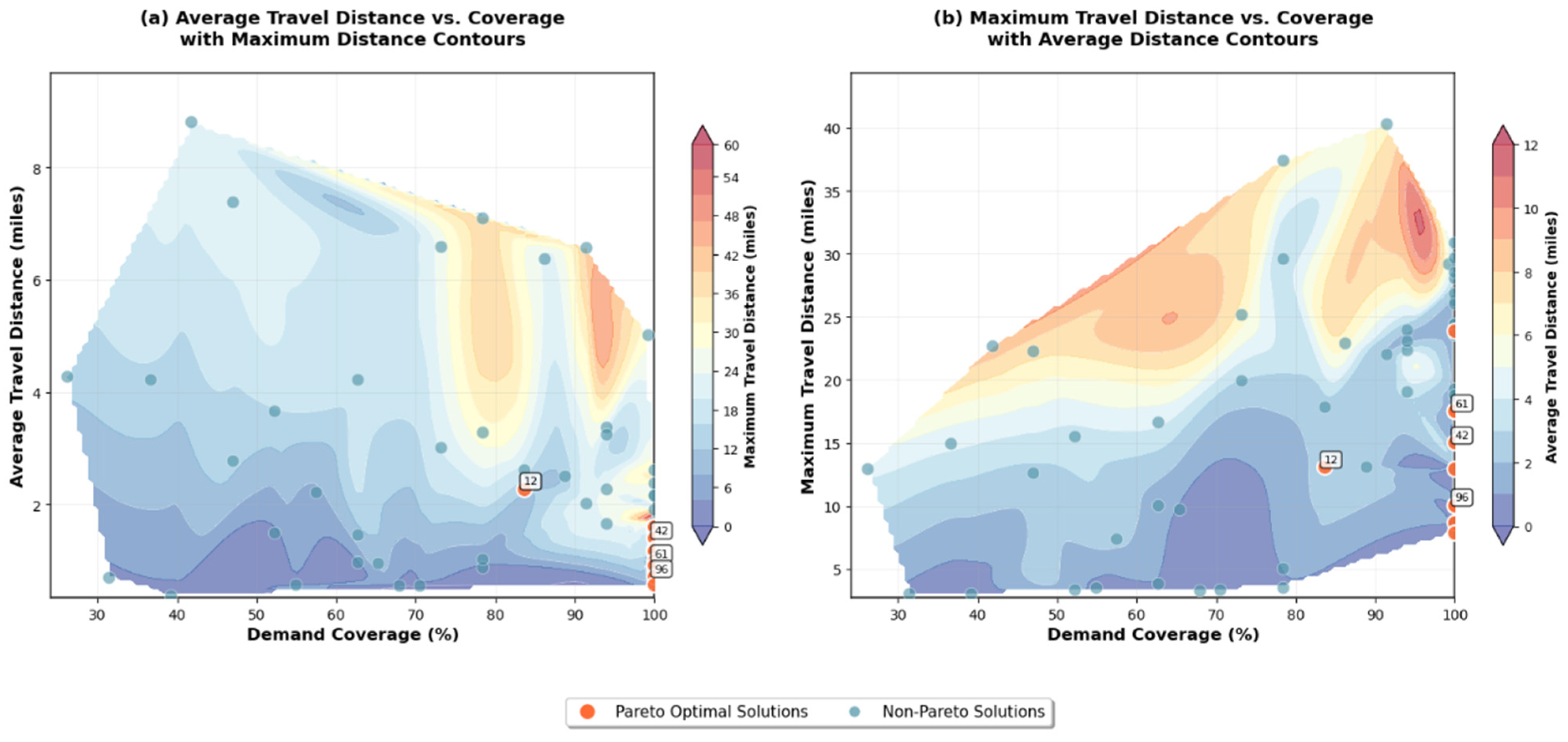

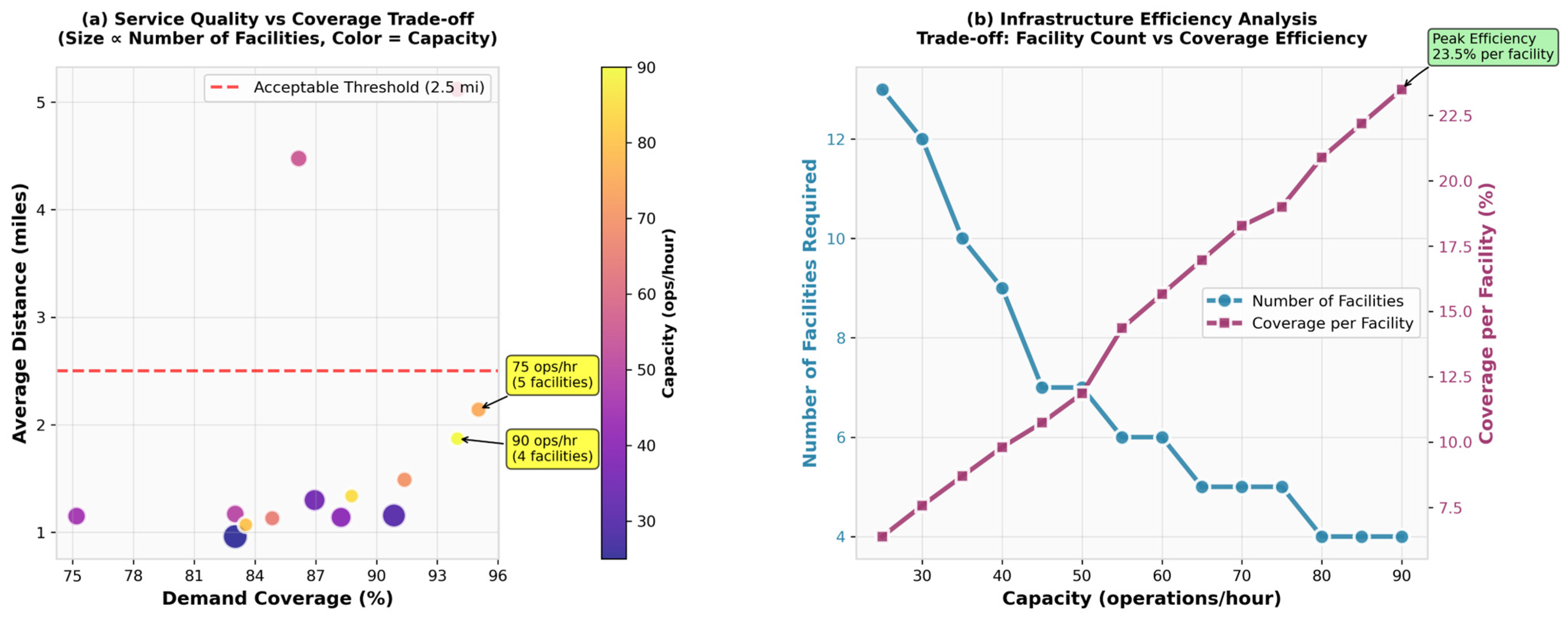
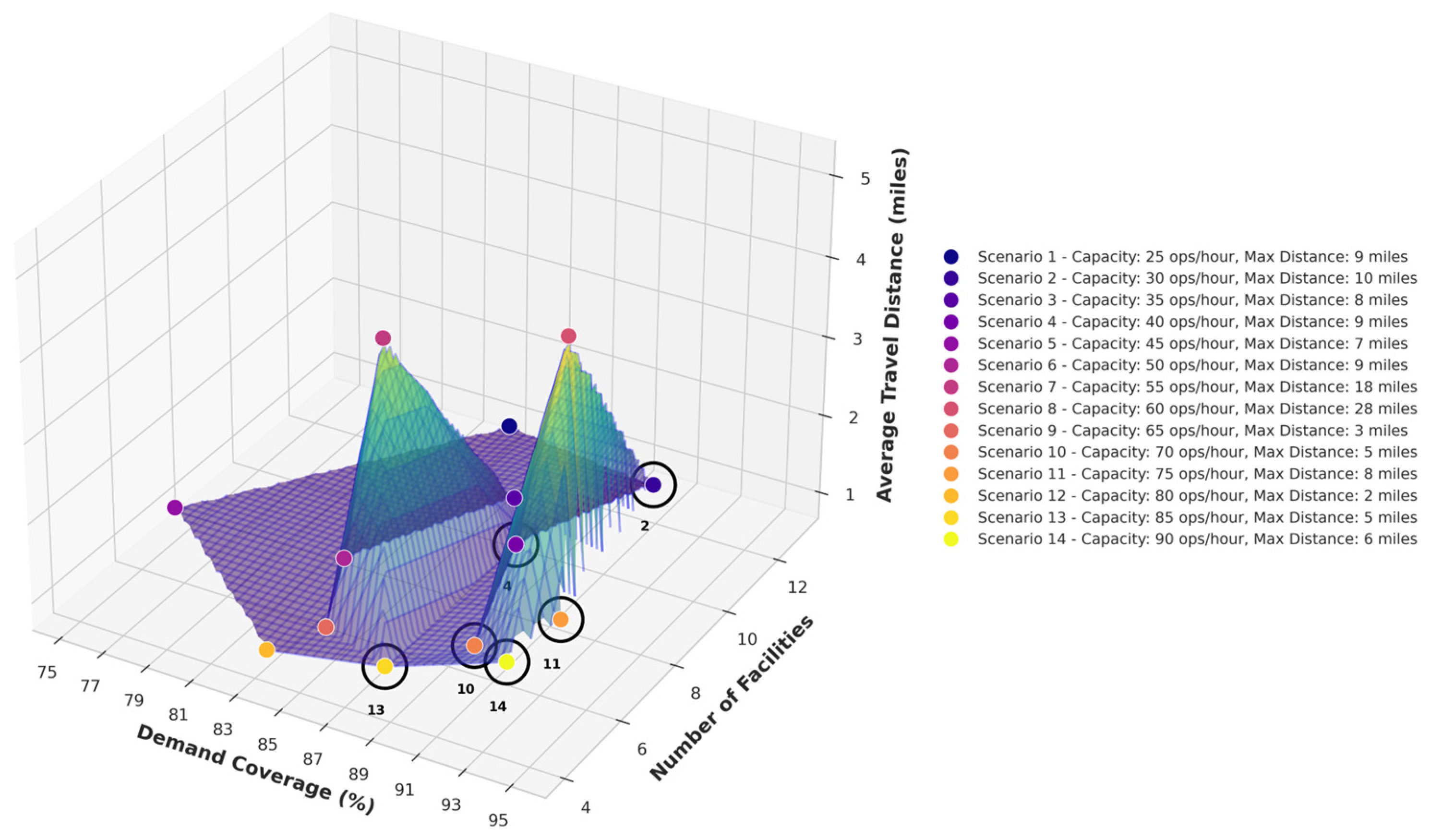
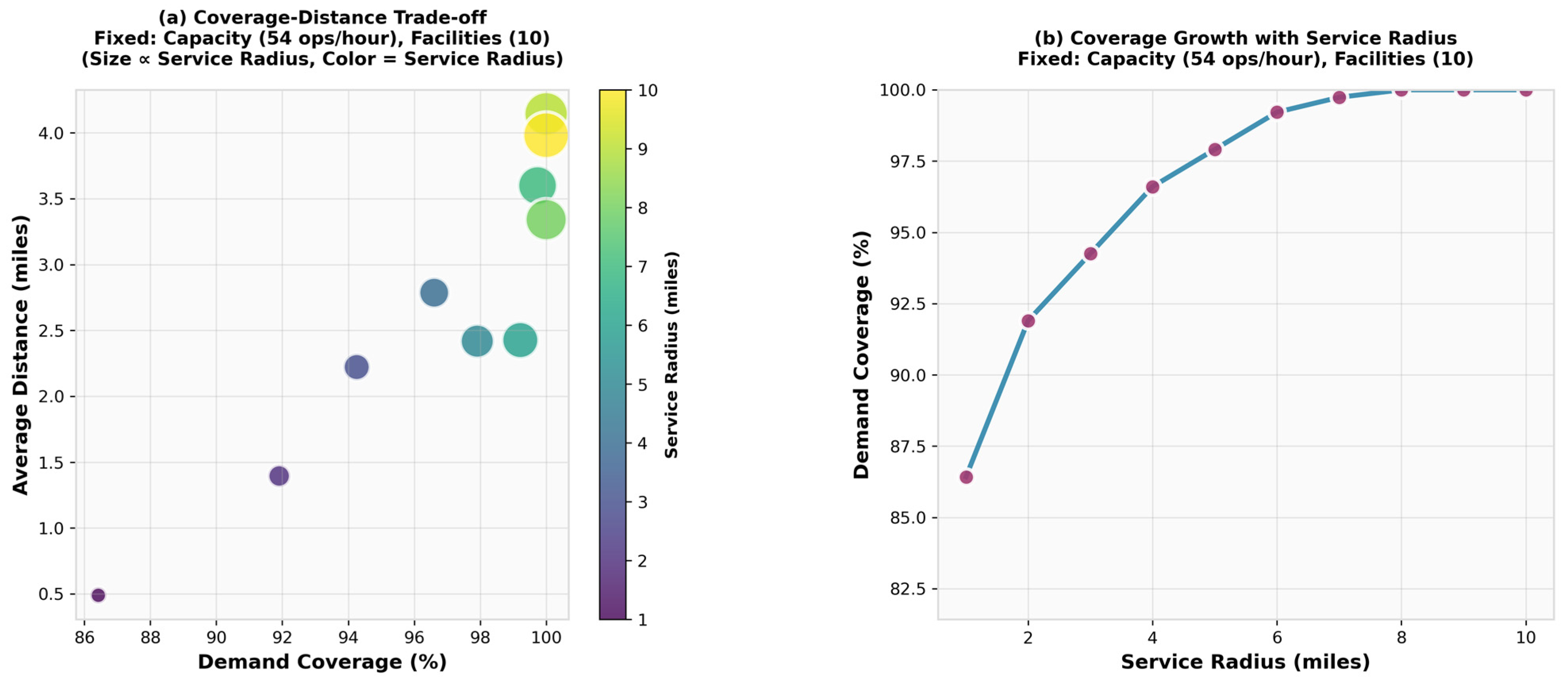

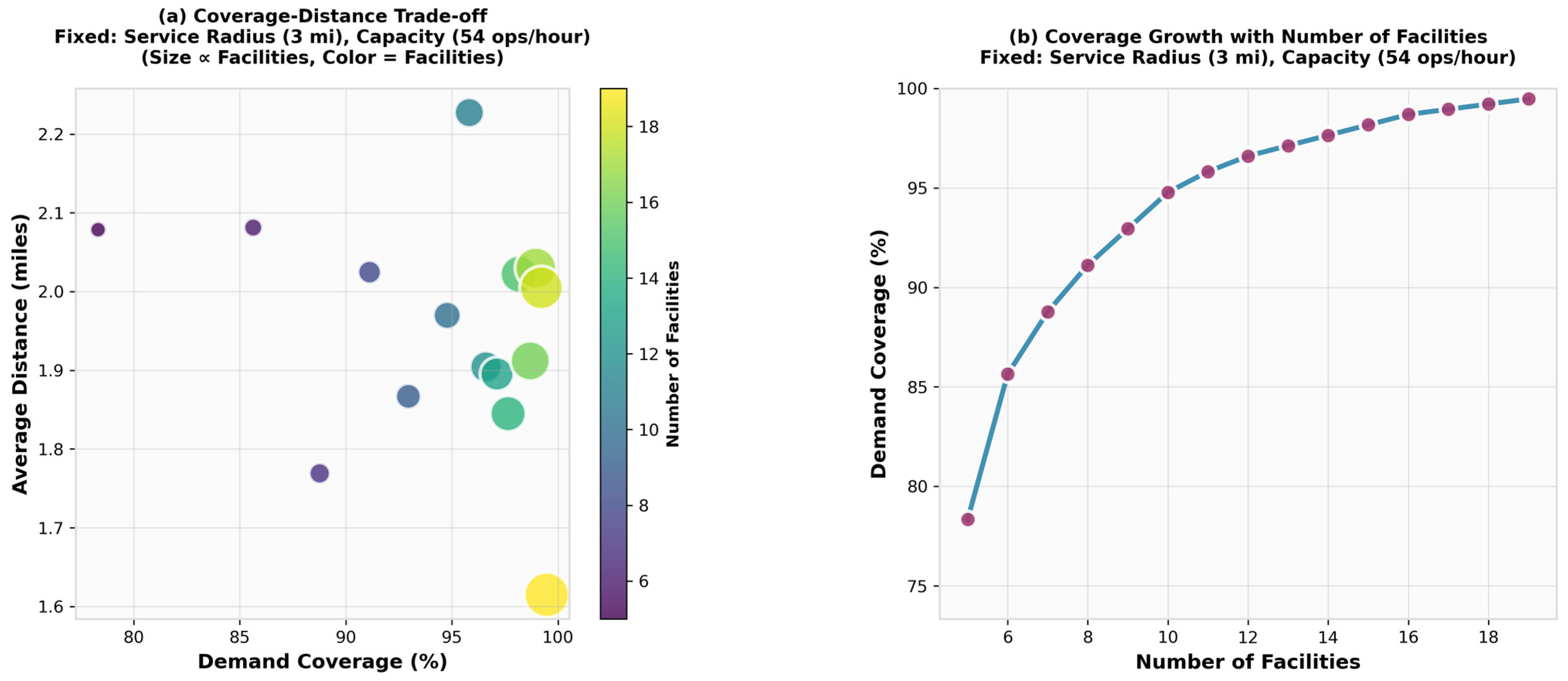
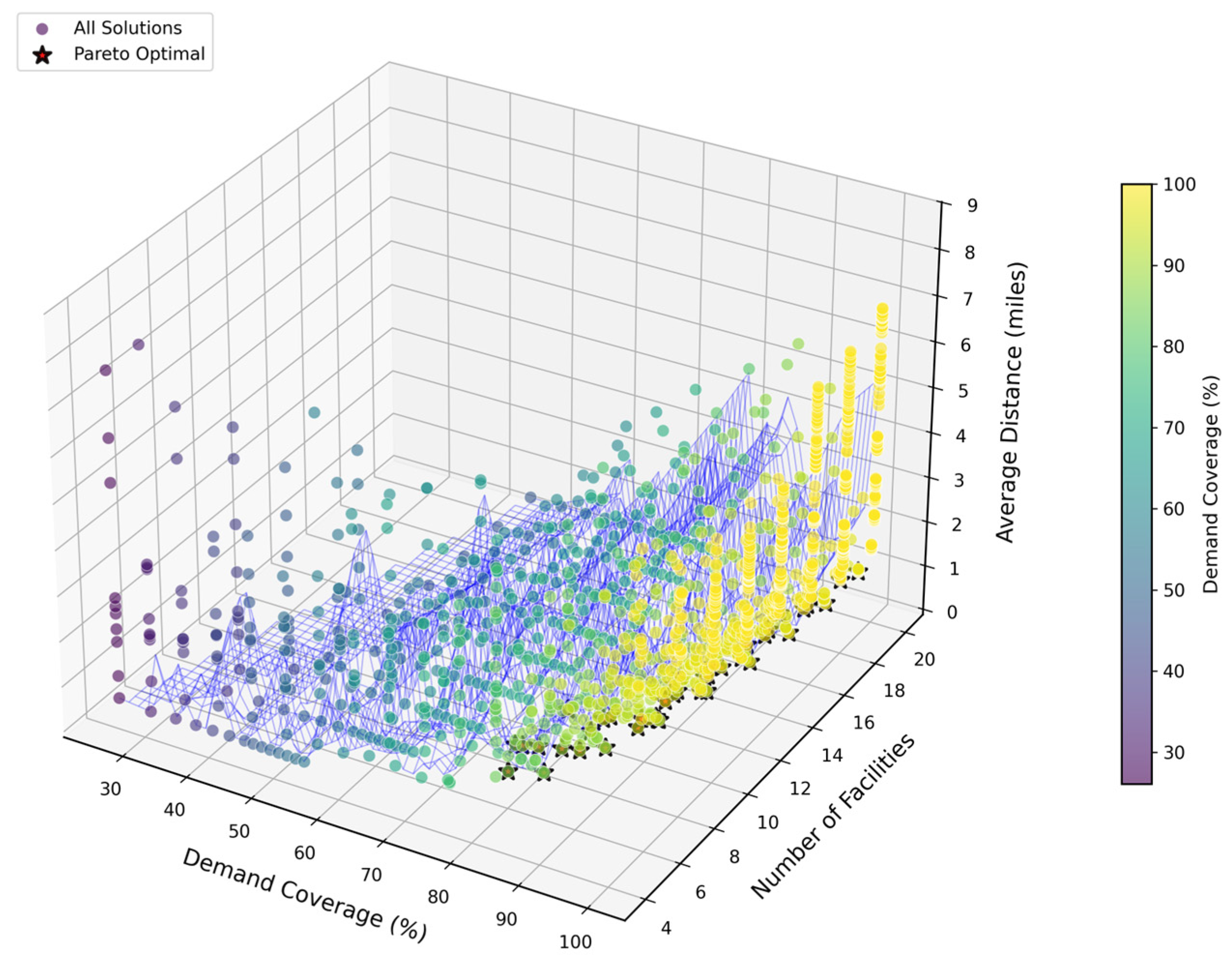

| Symbol | Description |
|---|---|
| Total generalized cost of UAM trip r | |
| Origin location of trip request | |
| Set of considered airports (i.e., destinations) | |
| Set of operational vertiports (subset of candidate nodes | |
| Selected vertiport for UAM trip from | |
| Binary decision variable for trip using vertiport | |
| Access leg time from to vertiport | |
| Cruise flight time from vertiport to airport | |
| Cost per mile for each ground transport mode | |
| UAM cruise time between and | |
| Walking penalty factor | |
| Value of time ($/hr) | |
| Walking time between origin and vertiport | |
| UAM base cost | |
| UAM cost per mile flown | |
| Assumed speed of UAM aircraft | |
| Air distance from vertiport to airport | |
| Distance from origin to vertiport | |
| Adjusting factor | |
| Total ground travel time between origin and airport |
Disclaimer/Publisher’s Note: The statements, opinions and data contained in all publications are solely those of the individual author(s) and contributor(s) and not of MDPI and/or the editor(s). MDPI and/or the editor(s) disclaim responsibility for any injury to people or property resulting from any ideas, methods, instructions or products referred to in the content. |
© 2025 by the authors. Licensee MDPI, Basel, Switzerland. This article is an open access article distributed under the terms and conditions of the Creative Commons Attribution (CC BY) license (https://creativecommons.org/licenses/by/4.0/).
Share and Cite
Volakakis, V.; Mahmassani, H.S. Strategic Vertiport Placement for Airport Access: Utilizing Urban Air Mobility for Accelerated and Reliable Transportation. Infrastructures 2025, 10, 242. https://doi.org/10.3390/infrastructures10090242
Volakakis V, Mahmassani HS. Strategic Vertiport Placement for Airport Access: Utilizing Urban Air Mobility for Accelerated and Reliable Transportation. Infrastructures. 2025; 10(9):242. https://doi.org/10.3390/infrastructures10090242
Chicago/Turabian StyleVolakakis, Vasileios, and Hani S. Mahmassani. 2025. "Strategic Vertiport Placement for Airport Access: Utilizing Urban Air Mobility for Accelerated and Reliable Transportation" Infrastructures 10, no. 9: 242. https://doi.org/10.3390/infrastructures10090242
APA StyleVolakakis, V., & Mahmassani, H. S. (2025). Strategic Vertiport Placement for Airport Access: Utilizing Urban Air Mobility for Accelerated and Reliable Transportation. Infrastructures, 10(9), 242. https://doi.org/10.3390/infrastructures10090242





